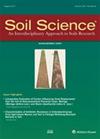Managing soil organic carbon in tropical agroecosystems: evidence from four long-term experiments in Kenya
4区 农林科学
Q2 Agricultural and Biological Sciences
引用次数: 2
Abstract
Abstract. In sub-Saharan Africa, maize is one of the most important staple crops, but long-term maize cropping with low external inputs has been associated with the loss of soil fertility. While adding high-quality organic resources combined with mineral fertilizer has been proposed to counteract this fertility loss, the long-term effectiveness and interactions with site properties still require more understanding. This study used repeated measurements over time to assess the effect of different quantities and qualities of organic resource addition combined with mineral nitrogen (N) on the change of soil organic carbon (SOC) contents over time (and SOC stocks in the year 2021) in four ongoing long-term experiments in Kenya. These experiments were established with identical treatments in moist to dry climates, on coarse to clayey soil textures, and have been conducted for at least 16 years. They received organic resources in quantities equivalent to 1.2 and 4 t C ha−1 yr−1 in the form of Tithonia diversifolia (high quality, fast turnover), Calliandra calothyrsus (high quality, intermediate turnover), Zea mays stover (low quality, fast turnover), sawdust (low quality, slow turnover) and local farmyard manure (variable quality, intermediate turnover). Furthermore, the addition of 240 kg N ha−1 yr−1 as mineral N fertilizer or no fertilizer was the split-plot treatment. At all four sites, a loss of SOC was predominantly observed, likely because the sites had been converted to cropland only a few decades before the start of the experiments. Across sites, the average decline of SOC content over 19 years in the 0 to 15 cm topsoil layer ranged from 42 % to 13 % of the initial SOC content for the control and the farmyard manure treatments at 4 t C ha−1 yr−1, respectively. Adding Calliandra or Tithonia at 4 t C ha−1 yr−1 limited the loss of SOC contents to about 24 % of initial SOC, while the addition of sawdust, maize stover (in three of the four sites) and sole mineral N addition showed no significant reduction of SOC loss over the control. Site-specific analyses, however, did show that at the site with the lowest initial SOC content (about 6 g kg−1), the addition of 4 t C ha−1 yr−1 farmyard manure or Calliandra with mineral N led to a gain in SOC contents. The other sites lost SOC in all treatments, albeit at site-specific rates. While subsoil SOC stocks in 2021 were little affected by organic resource additions (no difference in three of the four sites), the topsoil SOC stocks corroborated the results obtained from the SOC content measurements (0–15 cm) over time. The relative annual change of SOC contents showed a higher site specificity in farmyard manure, Calliandra and Tithonia treatments than in the control treatment, suggesting that the drivers of site specificity in SOC buildup (soil mineralogy, soil texture, climate) need to be better understood for effective targeting management of organic resources. Farmyard manure showed the highest potential for reducing SOC losses, but the necessary quantities to build SOC are often not realistic for smallholder farmers in Africa. Therefore, additional agronomic interventions such as intercropping, crop rotations or the cultivation of crops with extended root systems are necessary to maintain or increase SOC.管理热带农业生态系统中的土壤有机碳:来自肯尼亚四个长期实验的证据
摘要在撒哈拉以南非洲,玉米是最重要的主粮作物之一,但长期玉米种植与低外部投入有关,导致土壤肥力丧失。虽然已提出添加优质有机资源与矿物肥料相结合来抵消这种肥力损失,但其长期有效性及其与场地性质的相互作用仍有待进一步了解。在肯尼亚进行的四项长期试验中,本研究利用随时间的重复测量方法,评估了不同数量和质量的有机资源添加与矿物氮(N)结合对土壤有机碳(SOC)含量随时间变化(以及2021年的SOC储量)的影响。这些实验是在潮湿和干燥的气候条件下,在粗糙和粘稠的土壤质地上进行的,并且已经进行了至少16年。他们获得的有机资源数量相当于1.2和4吨碳公顷- 1年- 1,其形式是Tithonia varfolia(高质量,快速周转)、Calliandra calothyrsus(高质量,中等周转)、玉米秸秆(低质量,快速周转)、锯末(低质量,缓慢周转)和当地农家肥(不稳定质量,中等周转)。在分块处理条件下,每隔1年- 1年分别施矿质氮肥或不施氮肥240 kg。在所有四个地点,主要观察到有机碳的损失,可能是因为这些地点在实验开始前几十年才转变为农田。各样地在4 t C / ha - 1 yr - 1处理下,0 ~ 15 cm表层土壤有机碳含量19年平均下降幅度分别为初始有机碳含量的42% ~ 13%。在4 t C / ha - 1 yr - 1条件下添加万年花或铁藤可将土壤有机碳的损失限制在初始有机碳的24%左右,而添加锯末、玉米秸秆(4个地点中的3个)和单独添加矿物氮对土壤有机碳的损失没有显著减少。然而,位点特异性分析表明,在初始有机碳含量最低的位点(约6 g kg - 1),添加4 t cha - 1 yr - 1农家肥或含矿质氮的万花菜可使有机碳含量增加。其他位点在所有处理中都失去了有机碳,尽管是在特定位点上。虽然2021年地下土壤有机碳储量受有机资源添加量的影响不大(4个站点中有3个站点没有差异),但表层土壤有机碳储量证实了有机碳含量随时间变化(0-15 cm)的测量结果。土壤有机碳含量的相对年际变化在农家肥、花青菜和铁藤处理中表现出比对照处理更高的立地特异性,表明需要更好地了解土壤矿物学、土壤质地、气候等土壤有机碳积累立地特异性的驱动因素,以便有效地进行有机资源的针对性管理。农家肥显示出减少有机碳损失的最大潜力,但对于非洲的小农来说,建立有机碳所需的数量往往是不现实的。因此,额外的农艺干预措施,如间作、轮作或种植根系延伸的作物,对于维持或增加有机碳是必要的。
本文章由计算机程序翻译,如有差异,请以英文原文为准。
求助全文
约1分钟内获得全文
求助全文
来源期刊

Soil Science
农林科学-土壤科学
CiteScore
2.70
自引率
0.00%
发文量
0
审稿时长
4.4 months
期刊介绍:
Cessation.Soil Science satisfies the professional needs of all scientists and laboratory personnel involved in soil and plant research by publishing primary research reports and critical reviews of basic and applied soil science, especially as it relates to soil and plant studies and general environmental soil science.
Each month, Soil Science presents authoritative research articles from an impressive array of discipline: soil chemistry and biochemistry, physics, fertility and nutrition, soil genesis and morphology, soil microbiology and mineralogy. Of immediate relevance to soil scientists-both industrial and academic-this unique publication also has long-range value for agronomists and environmental scientists.
 求助内容:
求助内容: 应助结果提醒方式:
应助结果提醒方式:


